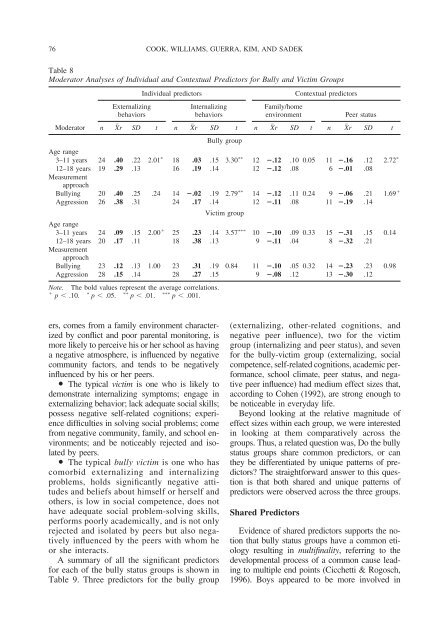Predictors of Bullying and Victimization in Childhood and Adolescence
Predictors of Bullying and Victimization in Childhood and Adolescence
Predictors of Bullying and Victimization in Childhood and Adolescence
Create successful ePaper yourself
Turn your PDF publications into a flip-book with our unique Google optimized e-Paper software.
76 COOK, WILLIAMS, GUERRA, KIM, AND SADEK<br />
Table 8<br />
Moderator Analyses <strong>of</strong> Individual <strong>and</strong> Contextual <strong>Predictors</strong> for Bully <strong>and</strong> Victim Groups<br />
Externaliz<strong>in</strong>g<br />
behaviors<br />
ers, comes from a family environment characterized<br />
by conflict <strong>and</strong> poor parental monitor<strong>in</strong>g, is<br />
more likely to perceive his or her school as hav<strong>in</strong>g<br />
a negative atmosphere, is <strong>in</strong>fluenced by negative<br />
community factors, <strong>and</strong> tends to be negatively<br />
<strong>in</strong>fluenced by his or her peers.<br />
Y The typical victim is one who is likely to<br />
demonstrate <strong>in</strong>ternaliz<strong>in</strong>g symptoms; engage <strong>in</strong><br />
externaliz<strong>in</strong>g behavior; lack adequate social skills;<br />
possess negative self-related cognitions; experience<br />
difficulties <strong>in</strong> solv<strong>in</strong>g social problems; come<br />
from negative community, family, <strong>and</strong> school environments;<br />
<strong>and</strong> be noticeably rejected <strong>and</strong> isolated<br />
by peers.<br />
Y The typical bully victim is one who has<br />
comorbid externaliz<strong>in</strong>g <strong>and</strong> <strong>in</strong>ternaliz<strong>in</strong>g<br />
problems, holds significantly negative attitudes<br />
<strong>and</strong> beliefs about himself or herself <strong>and</strong><br />
others, is low <strong>in</strong> social competence, does not<br />
have adequate social problem-solv<strong>in</strong>g skills,<br />
performs poorly academically, <strong>and</strong> is not only<br />
rejected <strong>and</strong> isolated by peers but also negatively<br />
<strong>in</strong>fluenced by the peers with whom he<br />
or she <strong>in</strong>teracts.<br />
A summary <strong>of</strong> all the significant predictors<br />
for each <strong>of</strong> the bully status groups is shown <strong>in</strong><br />
Table 9. Three predictors for the bully group<br />
Individual predictors Contextual predictors<br />
Internaliz<strong>in</strong>g<br />
behaviors<br />
Family/home<br />
environment Peer status<br />
Moderator n Xr SD t n Xr SD t n Xr SD t n Xr SD t<br />
Bully group<br />
Age range<br />
3–11 years 24 .40 .22 2.01 <br />
18 .03 .15 3.30 <br />
12 .12 .10 0.05 11 .16 .12 2.72 <br />
12–18 years<br />
Measurement<br />
approach<br />
19 .29 .13 16 .19 .14 12 .12 .08 6 .01 .08<br />
<strong>Bully<strong>in</strong>g</strong> 20 .40 .25 .24 14 .02 .19 2.79 <br />
14 .12 .11 0.24 9 .06 .21 1.69 <br />
Aggression 26 .38 .31 24 .17 .14 12 .11 .08 11 .19 .14<br />
Victim group<br />
Age range<br />
3–11 years 24 .09 .15 2.00 25 .23 .14 3.57 10 .10 .09 0.33 15 .31 .15 0.14<br />
12–18 years<br />
Measurement<br />
approach<br />
20 .17 .11 18 .38 .13 9 .11 .04 8 .32 .21<br />
<strong>Bully<strong>in</strong>g</strong> 23 .12 .13 1.00 23 .31 .19 0.84 11 .10 .05 0.32 14 .23 .23 0.98<br />
Aggression 28 .15 .14 28 .27 .15 9 .08 .12 13 .30 .12<br />
Note. The bold values represent the average correlations.<br />
<br />
p .10.<br />
<br />
p .05.<br />
<br />
p .01.<br />
<br />
p .001.<br />
(externaliz<strong>in</strong>g, other-related cognitions, <strong>and</strong><br />
negative peer <strong>in</strong>fluence), two for the victim<br />
group (<strong>in</strong>ternaliz<strong>in</strong>g <strong>and</strong> peer status), <strong>and</strong> seven<br />
for the bully-victim group (externaliz<strong>in</strong>g, social<br />
competence, self-related cognitions, academic performance,<br />
school climate, peer status, <strong>and</strong> negative<br />
peer <strong>in</strong>fluence) had medium effect sizes that,<br />
accord<strong>in</strong>g to Cohen (1992), are strong enough to<br />
be noticeable <strong>in</strong> everyday life.<br />
Beyond look<strong>in</strong>g at the relative magnitude <strong>of</strong><br />
effect sizes with<strong>in</strong> each group, we were <strong>in</strong>terested<br />
<strong>in</strong> look<strong>in</strong>g at them comparatively across the<br />
groups. Thus, a related question was, Do the bully<br />
status groups share common predictors, or can<br />
they be differentiated by unique patterns <strong>of</strong> predictors?<br />
The straightforward answer to this question<br />
is that both shared <strong>and</strong> unique patterns <strong>of</strong><br />
predictors were observed across the three groups.<br />
Shared <strong>Predictors</strong><br />
Evidence <strong>of</strong> shared predictors supports the notion<br />
that bully status groups have a common etiology<br />
result<strong>in</strong>g <strong>in</strong> multif<strong>in</strong>ality, referr<strong>in</strong>g to the<br />
developmental process <strong>of</strong> a common cause lead<strong>in</strong>g<br />
to multiple end po<strong>in</strong>ts (Cicchetti & Rogosch,<br />
1996). Boys appeared to be more <strong>in</strong>volved <strong>in</strong>
















